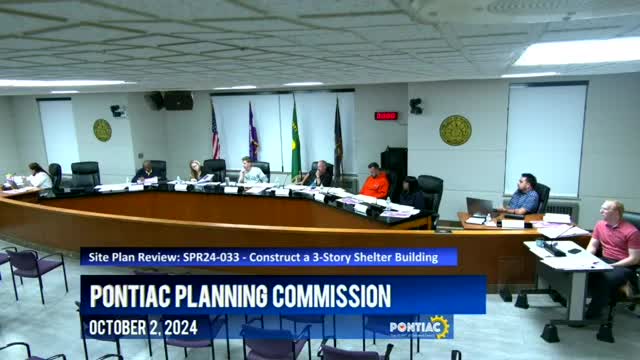New shelter design aims to transform homeless services
October 02, 2024 | Pontiac, Oakland County, Michigan
This article was created by AI summarizing key points discussed. AI makes mistakes, so for full details and context, please refer to the video of the full meeting. Please report any errors so we can fix them. Report an error »

During a recent government meeting, discussions centered around the design and functionality of a proposed new shelter facility in Pontiac, Michigan, spearheaded by HOPE Shelters. The meeting highlighted the architectural considerations and community impact of the project, which aims to provide a more dignified living environment for individuals experiencing homelessness.
Key concerns raised included the building's orientation and compatibility with the surrounding residential neighborhoods. Questions were posed about whether the design should focus more towards Baldwin or Rundell streets, given the single-family residential zoning to the north. The architectural team, led by Bernard Grant from Stantec, emphasized the importance of ensuring that the new structure harmonizes with the existing community aesthetics while enhancing the corridor.
Brian Wright, the executive director of HOPE Shelters, provided insights into the organization's mission and the necessity for a facility that offers individual rooms and bathrooms, a shift from their current congregate setting. This change is aimed at improving the dignity and privacy of guests, particularly in light of lessons learned during the COVID-19 pandemic. Wright noted that the new facility would not only accommodate more guests but also provide essential services, including a wellness clinic and office space for case management.
The design features a rear entry for new guests to minimize street congestion and enhance privacy, while the materials chosen for the building aim to reflect a residential feel, countering any clinical impressions. The architectural team assured that the design would include landscaping and screening to mitigate any potential concerns from neighboring residents.
Commissioners expressed support for the project, acknowledging its potential to significantly improve the local response to homelessness. The proposal includes a parking plan that exceeds the minimum requirements, although the actual demand is expected to be lower, as many guests arrive via public transport or are dropped off.
Overall, the meeting underscored a collaborative effort between the city, HOPE Shelters, and the architectural team to create a facility that not only meets the immediate needs of the homeless population but also integrates thoughtfully into the Pontiac community. The project is seen as a progressive step towards addressing homelessness with dignity and respect.
Key concerns raised included the building's orientation and compatibility with the surrounding residential neighborhoods. Questions were posed about whether the design should focus more towards Baldwin or Rundell streets, given the single-family residential zoning to the north. The architectural team, led by Bernard Grant from Stantec, emphasized the importance of ensuring that the new structure harmonizes with the existing community aesthetics while enhancing the corridor.
Brian Wright, the executive director of HOPE Shelters, provided insights into the organization's mission and the necessity for a facility that offers individual rooms and bathrooms, a shift from their current congregate setting. This change is aimed at improving the dignity and privacy of guests, particularly in light of lessons learned during the COVID-19 pandemic. Wright noted that the new facility would not only accommodate more guests but also provide essential services, including a wellness clinic and office space for case management.
The design features a rear entry for new guests to minimize street congestion and enhance privacy, while the materials chosen for the building aim to reflect a residential feel, countering any clinical impressions. The architectural team assured that the design would include landscaping and screening to mitigate any potential concerns from neighboring residents.
Commissioners expressed support for the project, acknowledging its potential to significantly improve the local response to homelessness. The proposal includes a parking plan that exceeds the minimum requirements, although the actual demand is expected to be lower, as many guests arrive via public transport or are dropped off.
Overall, the meeting underscored a collaborative effort between the city, HOPE Shelters, and the architectural team to create a facility that not only meets the immediate needs of the homeless population but also integrates thoughtfully into the Pontiac community. The project is seen as a progressive step towards addressing homelessness with dignity and respect.
View full meeting
This article is based on a recent meeting—watch the full video and explore the complete transcript for deeper insights into the discussion.
View full meeting
